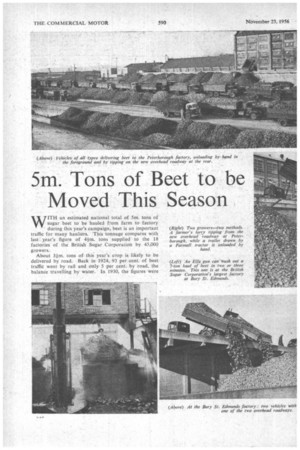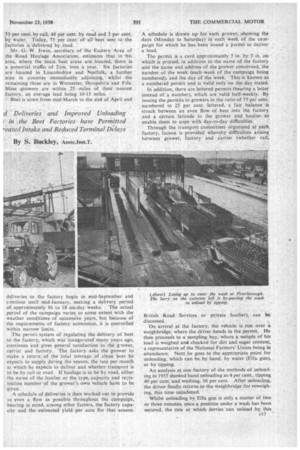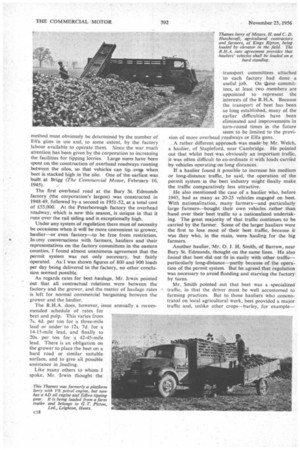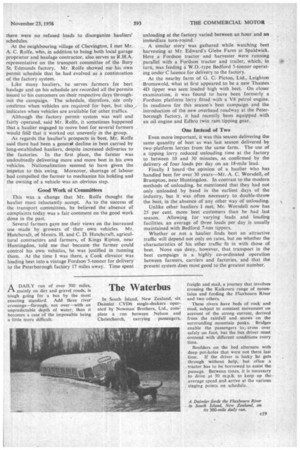5m. Tons of Beet to be Moved This Season
Page 56

Page 57

Page 58

Page 59

If you've noticed an error in this article please click here to report it so we can fix it.
WITH an estimated national total of 5m. tons of sugar beet to be hauled from farm to factory during this year's campaign, beet is an important traffic for many hauliers. This tonnage compares with last year's figure of 4fm. tons supplied to the 18 factories of the British Sugar Corporation by 45,000 growers.
About 31rm tons of this year's crop is likely to be delivered by road. Back in 1924, 93 per cent, of beet traffic went by rail and only 5 per cent, by road, the balance travelling by water. In 1930, the figures were
53 per cent, by rail, 44 per cent, by road and 3 per cent. by water. Today, 75 per cent. of all beet sent to the factories is delivered by road.
Mr. G. W. Irwin, secretary of the Eastern Area of the Road Haulage Association, estimates that in -his area, where the main beet areas are located, there_ is a potential traffic of 21m. tons a year. Six factories are located in Lincolnshire and Norfolk, a further nine in counties immediately adjoining, whilst the remaining three are in Worcester, Shropshire and Fife. Most growers are within 25 miles of their nearest factory, an average lead being 10-15 miles.
Beet is sewn from mid-March to the end of April and deliveries to the factory begin in mid-September and cantinue until mid-January, making a delivery period of approximately 16 to 18 six-day weeks. The actual period of the campaign varies to some extent with the weather conditions of successive years, but because of the requirements of factory economics, it is controlled within narrow limits.
The permit system of regulating the delivery of beet to the factory, which was inaugurated many years ago, continues and gives general satisfaction to the grower, carrier and factory. The factory asks the grower to make a retu7n of the total tonnage of clean beet he expects to supply during the season, the rate per month at which he expects to deliver and whether transport is to be by rail or road. If haulage is to be by road, either the name of the haulier or the type, capacity and reyistration number of the grower's own vehicle have to be given.
A schedule of deliveries is then worked out to provide as even a flow as possible throughout the campaign, bearing in mind, among other factors, the factory capacity and the estimated yield per acre for that season. A schedule is drawn up for each grower, showing the days (Monday to Saturday) in each week of the campaign for which he has been issued a permit to deliver a load.
The permit is a card approximately 5 in. .by 3 in. on which is printed, in addition to the name of the factory and the name and address of the grower concerned, the number of the week (each week of the campaign being numbered), and the day of the week. This is known as a numbered permit and is valid only on the day stated.
In addition, there are lettered permits (bearing a letter instead of a number), which are valid half-weekly. By issuing the permits to growers in the ratio of 75 per cent. numbered to 25 per cent, lettered, a fair balance is struck between an even flow of beet into the factory and a certain latitude to the grower and haulier to enable them to cope with day-to-day difficulties.
Through the transport conitnittees organized at each factory, liaison is provided whereby diffrculties arising between grower, factory and carrier (whether rail, British Road Services or private haulier), can be discussed.
On arrival at the factory, the vehicle is run over a weighbridge, where the driver hands in the permit. He then proceeds to a sampling bay, where a sample of his load is weighed an checked for dirt and sugar content, a representative of the National Farmers' Union being in attendance. Next he goes to the appropriate point for unloading, which can be by hand, by water (Elfa gun), or by tipping.
An analysis at one factory of the methods of unloading in 1955 showed hand unloading as 4 per cent., tipping 40 per cent. and washing, 56 per cent. After unloading, the driver finally returns to the weighbridge for reweighing, this time unladened.
Whilst unloading by Elfa gun is only a matter of two or three minutes, once a position under a wash has been secured, the rate at which lorries can unload by this cu7 method must obviously be determined by the number of Ella guns in use and, to some extent, by the factory labour available to operate them. Since the war much attention has been given by the corporation to increasing the facilities for tipping lorries. Large sums have been spent on the construction of overhead roadways running between the silos, so that vehicles can tip even when beet is stacked high in the silo. One of the earliest was
built at Brigg (The Commercial Motor, February 16, 1945).
The first overhead road at the Bury St. Edmunds factory (the corporation's largest) was constructed in 1948-49, followed by.a second in 1951-52, at a total cost of 155,000. At the Peterborough factory the overhead roadway, which is new this season, is unique in that it runs over the rail siding and is exceptionally high.
Under any system of regulation there must of necessity be occasions when it will be more convenient to grower, haulier—or even factory—to be free from restriction.
tmy conversations with farmers, hauliers and their representatives on the factory committees in the eastern counties, I found almost unanimous agreement that the permit system was not only necessary, but fairly operated. As I was shown figures of 800 and 900 loads per day being delivered to the factory, no other conclusion seemed possible.
As regards rates for beet ,haulage, Mr. Irwin pointed out that all contractual relations were between the factory and the grower, and the matter of haulage rates is left for normal commercial bargaining between the grower and the haulier.
The R.H.A. does, however, issue annually a recommended schedule of rates for beet and pulp. This varies from 7s. 4d. per ton for a three-mile lead or under to 12s. 7d. for a 14-15-mile lead, and finally to 20s. per ton for a 42-45-mile lead. There is an obligation on the grower to place the beet on a hard road or similar suitable surface, and to give all possible assistance in Joading.
Like many others to whom I spoke, Mr. Irwin thought the transport committees attached to each factory had done a useful job. On these committees, at least two members are appointed to represent the interests of the R.H.A. Because the transport of beet has been so long established, many of the earlier difficulties have been eliminated and improvements in turn-round times in the future seem to be limited to the provision of more overhead roadways or Elfa guns.
A rather different approach was made by Mr. Welch, a haulier, of Stapleford, near Cambridge. He pointed out that whilst beet was obviously an important traffic, it was often difficult to co-ordinate it with loads carried by vehicles operating on long distances.
If a haulier found it possible to increase his medium or long-distance traffic, he said, the operation of the permit system in the beet industry might finally make the traffic comparatively less attractive.
He also mentioned the case of a haulier who, before 1945, had as many as 20-25 vehicles engaged on beet. With nationalization, many farmers—and particularly large farmers—bought their own vehicles rather than hand over their beet traffic to a nationalized undertaking. The great majority of that traffic continues to be carried by the farmer. Some of the larger hauliers were the first to lose most of their beet traffic, because it was they who, in the main, were hauling for the big farmers.
Another haulier,'Mr. 0. J. H. Smith, of Barrow, near Bury St. Edmunds, thought on the same lines. He also found that beet did not fit in easily with other traffic— particularly long-distance—partly because of the operation of the permit system. But he agreed that regulation was necessary to avoid flooding and starving the factory by turns.
Mr. Smith pointed out that beet was a specialized traffic, in that the driver must be -well accustomed to farming practices. But to those hauliers who concentrated on local agricultural work, beet provided a major traffic and, unlike other crops—barley, for example-
there were no refused loads to disorganize hauliers' schedules.
At the neighbouring village of Chevington, I met Mr. A. C. Rolfe, who, in addition to being both local garage proprietor and haulage contractor, also serves as R.H.A. representative on the transport committee of the Bury St. Edmunds factory. Mr. Rolfe showed mehis own permit schedule that he had evolved as a continuation of the factory system.
Like many hauliers, he serves farmers for beet haulage and on his schedule are recorded all the permits issued to his customers on their respective days throughout the campaign. The schedule, therefore, not only confirms when vehicles are required for beet, but also indicates when vehicles are available for other traffics.
Although the factory permitsystem was well and fairly operated, said Mr. Rolfe, it sometimes happened that a haulier engaged to move beet for several farmers would firid that it worked out unevenly in the group.
As regards the haulier's prospects in beet, Mr. Rolfe said there had been a generial decline in beet carried by long-established hauliers, despite increased deliveries to the factories. In the first place, the farmer was undoubtedly delivering more and more beet in his own vehicles. Nationalization seemed to have given the impetus to this swing. Moreover, shortage of labour had compelled the farmer to mechanize his holding and the owning of a vehicle was an obvious step.
Good Work of Committees
This was a change that Mr. Rolfe thought the haulier must reluctantly accept. As to the success of the transport committees, he believed the absence of complaints today was a fair comment on the good work done in the past.
Several farmers gave me their views on the increased use made by growers of their own vehicles. Mr. Hutchcraft, of Messrs. H. and C. D. Hutchcraft, agricultural contractors and farmers, of Kings Ripton, near Huntingdon, told me that because the farmer could control his own vehicles, he was justified in running them. At the time I was there, a Cook elevator was loading beet into a vintage Fordsoni-tonner for delivery to the Peterborough factory 17 miles away. Time spent
unloading at the factory varied between an hour and an immediate turn-round.
. A similar story was gathered while watching beet harvesting at Mr. Edward's Glebe Farm at Spaldwick. Here a Fordson tractor and harvester were running parallel with a Fordson tractor and trailer, which, in :to turn, was feeding a W.D.-type Bedford 5-tonner operating under C licence for delivery to the factory.
At the nearby farm of G. C. Picton, Ltd., Leighton Bromswold, what at first appeared to be a new Thames 4D tipper was seen loaded high with beet. On closer examination, it was found to have been formerly a Fordson platform lorry fitted with a V8 petrol engine. In readiness for this season's beet campaign and the introduction of the new overhead roadway at the Peterborough factory, it had recently been equipped with an oil engine and Edbro twin ram tipping gear.
One Instead of Two
Even more important, it was this season delivering the same quantity of beet as was last season delivered by two platform lorries from the same farm. The use of a tipping lorry reduced unloading time at the factory to between 10 and 30 minutes, as confirmed by the delivery of four loads per day on an 18-mile•lead.
Finally I heard the opinion of a haulier who has handled beet for over 30 years—Mr.-A. C. Worsdell, of Brampton, near Huntingdon. In contrast to the modern methods of unloading, he mentioned that they had not only unloaded by hand in the earliest days of the industry, but it was often necessary to double-throw the beet, in the absence of any other way of unloading.
Unlike other hauliers I met, Mr. Worsdell now has 25 per cent. more beet customers than he had last season. Allowing for varying leads and loading facilities, an average of three loads per day is usually maintained with Bedford 7-ton tippers.
Whether or not a haulier finds beet an attractive traffic will depend not only on rates, but on whether the characteristics of his other traffic fit in with those of beet. None can deny, however, that transport in the beet campaign is a highly co-ordinated operation between farmers, carriers and factories, and that the present system does most good to the greatest number.
















































































































